INSTITUT SUPERIEUR D'ANTHROPOLOGIE
INSTITUTE OF ANTHROPOLOGY
ONLINE COURSES / COURS A DISTANCE
INSCRIPTION 2012 / Session III : Juillet 2012
REGISTRATION 2012 / Term III : July 2012
MEXIQUE – 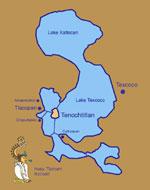 Mexico City - Archaeologists in Mexico City have unearthed the skulls and other bones of 15 people, most of them the children of traveling merchants during Aztec times. Researcher Alejandra Jasso Pena says they also found ceramic flutes, bowls, incense burners, the remains of a dog that was sacrificed to accompany a child in the afterlife and other artifacts of a pre-Columbian civilization. Jasso Pena said Friday that construction was about to start on five buildings in a Mexico City neighborhood when the National Institute of Anthropology and History asked to carry out an excavation of the site first. Experts suspected the site was an important ceremonial center for the Tepanec tribe between 1200 and 1300. The influential traders living there were called Pochtecas. Archaeologists say excavation is continuing at the site.
Mexico City - Archaeologists in Mexico City have unearthed the skulls and other bones of 15 people, most of them the children of traveling merchants during Aztec times. Researcher Alejandra Jasso Pena says they also found ceramic flutes, bowls, incense burners, the remains of a dog that was sacrificed to accompany a child in the afterlife and other artifacts of a pre-Columbian civilization. Jasso Pena said Friday that construction was about to start on five buildings in a Mexico City neighborhood when the National Institute of Anthropology and History asked to carry out an excavation of the site first. Experts suspected the site was an important ceremonial center for the Tepanec tribe between 1200 and 1300. The influential traders living there were called Pochtecas. Archaeologists say excavation is continuing at the site.
http://www.huffingtonpost.com/huff-wires/20120713/lt-mexico-archaeology/
USA – 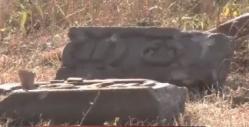 Granger - A South Bend archaeologist is now looking into a mistaken discovery. Landscapers found bones just feet away from a popular shopping plaza in Granger. Those bones are believed to be from an animal and date back to the 1870s. The archaeologist who examined the remains said people stumble across bones, artifacts and tombstone all the time. What is unusual about this discovery are the stones that were also found. The erie discovery was examined by Vanderveen, who said the bones discovered appear to be the remains from a cow. "So, there is part of a long bone and a couple of rib bones," said Vanderveen. However, the stones remain a mystery. Three intact stones, along with two halves were found. What is confusing to Vanderveen is that the stones are made of cement and have unrecognizable symbols. "The first one appears to be a Bible and that one you find all the time on tombstones. The second one is a little bit more abstract. It could be a dove or it could be a flame," said Vanderveen. Vanderveen said the artifacts were found on the property of a home dating back to before the 1870s and said the history of the home could reveal important details about the findings. "I am going to have to do a bit more research and the DNR in Indianapolis is also going to look at the age of the house, who owned the house, what these things may have been and what other kind of settlement was here," said Vanderveen.
Granger - A South Bend archaeologist is now looking into a mistaken discovery. Landscapers found bones just feet away from a popular shopping plaza in Granger. Those bones are believed to be from an animal and date back to the 1870s. The archaeologist who examined the remains said people stumble across bones, artifacts and tombstone all the time. What is unusual about this discovery are the stones that were also found. The erie discovery was examined by Vanderveen, who said the bones discovered appear to be the remains from a cow. "So, there is part of a long bone and a couple of rib bones," said Vanderveen. However, the stones remain a mystery. Three intact stones, along with two halves were found. What is confusing to Vanderveen is that the stones are made of cement and have unrecognizable symbols. "The first one appears to be a Bible and that one you find all the time on tombstones. The second one is a little bit more abstract. It could be a dove or it could be a flame," said Vanderveen. Vanderveen said the artifacts were found on the property of a home dating back to before the 1870s and said the history of the home could reveal important details about the findings. "I am going to have to do a bit more research and the DNR in Indianapolis is also going to look at the age of the house, who owned the house, what these things may have been and what other kind of settlement was here," said Vanderveen.
VIDEO = http://www.abc57.com/news/local/Bones-found-in-Granger-162024555.html
ARMENIE – 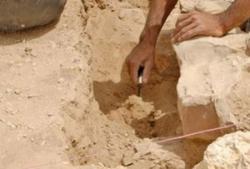 Gegharkunik - The Armenian-Italian joint expedition has been making archeological researches in the region of Gegharkunik for nineteen years. The expedition is led by the Rome Middle East countries institute scientist, researcher, archeologist and orientalist Rafaelle Bishione and the archeologist, Urartologist of the Armenian NAS of Archaeology and Ethnography Institute, Simon Hmayakyan. The expedition detects, corrects, studies and draws a map of new monuments. The research materials were published in a volume and distributed to the European countries, the second volume is being prepared for publication. The research results were regularly translated into Armenian and Italian. As “Armenpress” was informed by Simon Hmayakyan, the experts made researches in Norashen, Zolakar, Chkalovka, Tsovinar and Gavar. The expedition also visited the Geological Museum of the Gavar city to study the Artashes stone found in the area of Lanjaghbyur. At the same time the expedition observed the ruins, defensive and urban system remnants of the city of Khaldi located in the area of Gavar.
Gegharkunik - The Armenian-Italian joint expedition has been making archeological researches in the region of Gegharkunik for nineteen years. The expedition is led by the Rome Middle East countries institute scientist, researcher, archeologist and orientalist Rafaelle Bishione and the archeologist, Urartologist of the Armenian NAS of Archaeology and Ethnography Institute, Simon Hmayakyan. The expedition detects, corrects, studies and draws a map of new monuments. The research materials were published in a volume and distributed to the European countries, the second volume is being prepared for publication. The research results were regularly translated into Armenian and Italian. As “Armenpress” was informed by Simon Hmayakyan, the experts made researches in Norashen, Zolakar, Chkalovka, Tsovinar and Gavar. The expedition also visited the Geological Museum of the Gavar city to study the Artashes stone found in the area of Lanjaghbyur. At the same time the expedition observed the ruins, defensive and urban system remnants of the city of Khaldi located in the area of Gavar.
http://armenpress.am/eng/news/687685/the-armenian-italian-expedition-making-archaeological-excavations-in-the-gegharkunik-region.html
SUEDE – 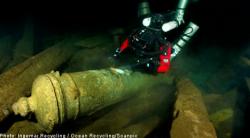 Oland - Divers have recovered a number of 16th century silver coins from the wreckage of the legendary Swedish warship Mars, which was discovered last year off the coast of the Baltic sea island of Öland. "The coins are in excellent condition and of great historic interest, especially considering where they were found," the diving expedition organizers which found the wreck, Ocean Discovery/Deep Sea Productions, said in a statement, according to local news website Barometern.se. According to the divers, the silver coins date from the time of Sweden's King Erik XIV, who ruled over Sweden between 1560 and 1568. The mighty Mars was one of the largest ships of its time with 107 guns and a crew of 800 men, both out-sizing and outgunning the famous warship Vasa, which has been on show in Stockholm since it was lifted from city's harbour in the 1960s. The search for the legendary Mars continued for decades until divers announced in August they had come across a wreck they were convinced was that of the legendary battleship. The Mars was the largest ship in the Baltic in its heyday and was sunk, only a year after its maiden voyage, during a sea battle with the Danish-Lübeckian navy in 1564. After two days of ferocious fighting, Mars was hit by cannon fire and went up in smoke. In the ensuing kerfuffle the vessel went down and has been resting untouched in its watery grave for 447 years.
Oland - Divers have recovered a number of 16th century silver coins from the wreckage of the legendary Swedish warship Mars, which was discovered last year off the coast of the Baltic sea island of Öland. "The coins are in excellent condition and of great historic interest, especially considering where they were found," the diving expedition organizers which found the wreck, Ocean Discovery/Deep Sea Productions, said in a statement, according to local news website Barometern.se. According to the divers, the silver coins date from the time of Sweden's King Erik XIV, who ruled over Sweden between 1560 and 1568. The mighty Mars was one of the largest ships of its time with 107 guns and a crew of 800 men, both out-sizing and outgunning the famous warship Vasa, which has been on show in Stockholm since it was lifted from city's harbour in the 1960s. The search for the legendary Mars continued for decades until divers announced in August they had come across a wreck they were convinced was that of the legendary battleship. The Mars was the largest ship in the Baltic in its heyday and was sunk, only a year after its maiden voyage, during a sea battle with the Danish-Lübeckian navy in 1564. After two days of ferocious fighting, Mars was hit by cannon fire and went up in smoke. In the ensuing kerfuffle the vessel went down and has been resting untouched in its watery grave for 447 years.
http://www.thelocal.se/41982/20120712/
CHINE – 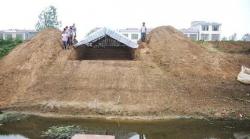 Suitang - The excavation to the fourth archaeological point of the Suitang Grand Canal (Sixian county-section) has just ended. During the excavation, archaeologists found not only many cultural relics, but also 20 footprints suspected of being left by people of the Song Dynasty. This is the first time that clear footprints have been found since the beginning of the excavation.
Suitang - The excavation to the fourth archaeological point of the Suitang Grand Canal (Sixian county-section) has just ended. During the excavation, archaeologists found not only many cultural relics, but also 20 footprints suspected of being left by people of the Song Dynasty. This is the first time that clear footprints have been found since the beginning of the excavation.
http://www.kaogu.cn/en/detail.asp?ProductID=3561